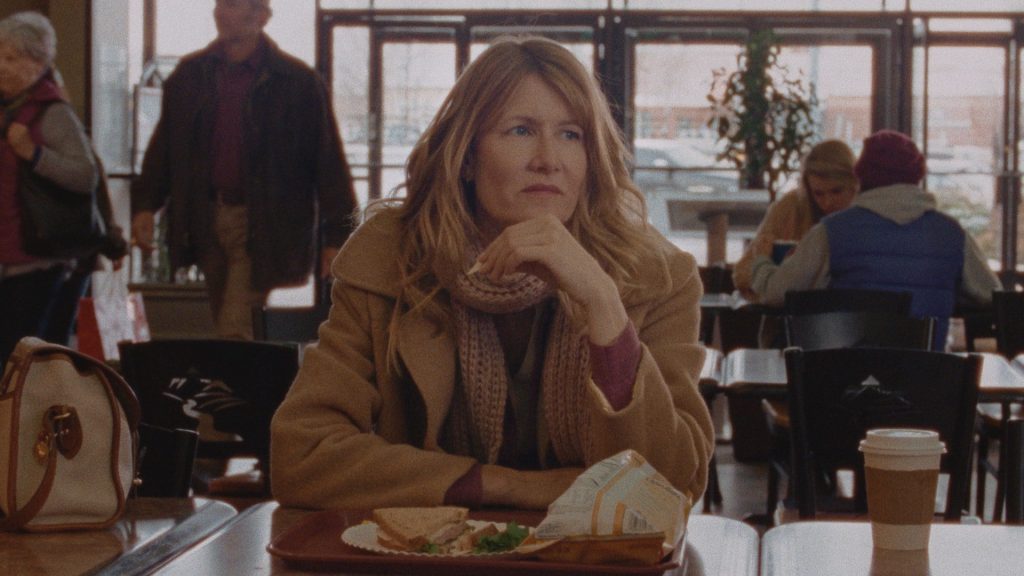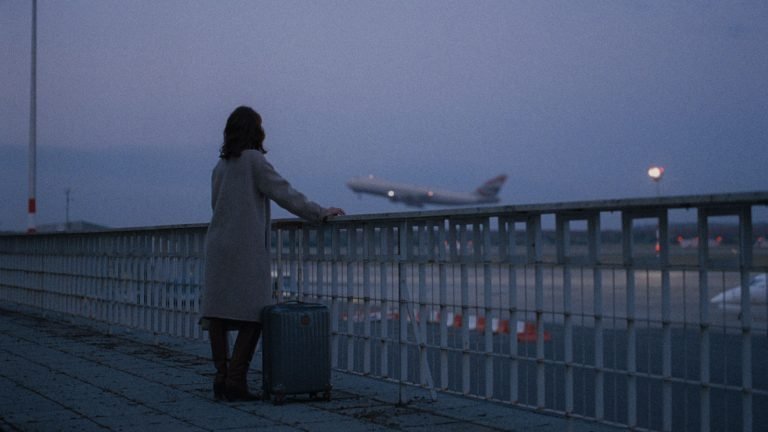
'Certain Women' Review
- Published on February 10, 2019
- by Igor Fishman
From the opening shot of Certain Women we are transported. The first thing we hear is the clanking hiss of the train, and then the landscape appears before us. We are in Montana, a gorgeous mountain hangs above the plain like a Bob Ross painting. The train is a speck in the distance and moves like molasses, and yet we still hear it’s din, time itself appears to expand and contract, motion and stillness exist simultaneously.
The train engine approaches us and slowly moves past the screen as the credits appear, and even then, up close, the movement of the train cars is almost imperceptible as the snaking wagons seem to stretch back to an infinity. In the next shot we see a building in town and hear casual conversation, and as we begin to enter the world of people, we continue to hear the passing train, a reminder that these moments are all nestled within one another, existing within a single fragment of time.
Kelly Reichardt is first and foremost a patient director, she is comfortable and confident taking her time and going slow. She deliberately contorts the depiction of time and space to create a personal, lived-in experience, at once dreamlike and exhaustively real. This is amplified by the wonderful sound design that highlights the smallest most mundane sounds of the day to day. It creates a feel that pulls you in, and it’s this attention to detail that creates a weary sense of the familiar.

One of the major filmmakers that comes to mind in comparing Reichardt’s approach to is that of the great late Chantal Akerman, whose work is an absolute masterclass in this type of quiet, yet effusively expressive filmmaking. Much like Akerman, Reichardt’s characters are often alienated from their environments, and struggle with a brooding loneliness that is heightened and exaggerated by a sparse, minimalist approach. In many ways I am reminded of Akerman’s Les Rendez-vous d’Anna about a director floating from city to city encountering strangers and friends, while feeling tired and lost in the worlds she occupies. A fascinating double feature could also be having this play alongside News From Home, within which Akerman explores the vast loneliness lurking underneath the bustling sights and sounds of New York City.
Additionally, in a number of interviews Reihcardt talks at length about how the films of Rainer Werener Fassbinder had shown her that small personal stories can be charged with powerful political undercurrents. For examples of this in Fassbinder, you could look to Fox and His Friends, about a working class man winning the lottery, or perhaps The Bitter Tears of Petra Von Kant, where a wealthy fashion designer hopelessly in love with a model, transfers all her frustration and anger onto her servant. Unlike Fassbinder though, Reichardt’s films aren’t nearly as caustic or angry, though often they are just as devastating in their conclusions.
It’s in this way that Reichardt knows that in telling the stories of these women in the modern American West she is, in her own beautifully quiet way, able to excavate and expose a number of key ideas. The stagnancy of an America in decline, as well as American womanhood in the face of an also declining, but still widely present patriarchy. These ideas manifest themselves in different ways, more often as melancholy than anger, despondency rather than fear. They exist on the periphery of the film even when it can seem like they pressing directly into it. As with most Reichardt films, this collection of thought accumulates and grows until the ending, which doesn’t propose to resolve or answer any of it, but instead demands of you, the viewer to do that work.

To give a sense of the plot, Certain Women, based on a collection of short stories by Maile Maloy, focuses on three episodes within the lives of three women. These stories intertwine in subtle ways. Laura Dern, Michelle Williams, and Lilly Gladstone play the three major characters, with Kristen Stewart playing a wonderful side character in the third story.
Laura Dern plays a lawyer with a stubborn client with a hopeless case, who she has been advising for the last eight months. Michelle Williams plays a woman trying to build a new home in Montana, alienated from her daughter as well as her husband, who we discover is having an affair, while Lily Gladstone’s character works alone on a farm, literally cut off from the outside world, and yearning for a meaningful connection. In fact, Lily Gladstone who is a relative newcomer, absolutely steals the show in the third act with a delicately quiet but resonant performance that gives the film a thundering emotional core.
Each of these characters is filled with a profound longing that they are unable to satisfy. Each character is in a state of yearning, hoping to uncover something to validate the small indignities of the day to day. Much like the train of the opening, each of the stories carries within it that very same tension of motion and stillness. Things change and time moves, and yet the world that exists around these characters stays static. The largest moments of impact at the climax of each of the stories, are themselves undercut by a pervading sense of futility. Each moment deflated in its own seemingly inevitable way.

Underlying each of these stories is a nagging throughline that the frustrations, alienation, and angst experienced by the women isn’t specific to their unique circumstances and stories, but is rather a pervasive and all encompassing malaise hanging over everyone. Despite the ways in which the women find themselves at odds with their environment, so do nearly all of the characters they meet.
This type of frustration is best expressed by the Kristen Stewart character forced to commute four hours after work to teach a night class on a subject she knows nothing about. Later in the film when Lily Gladstone shows her the local diner, we get to see a brief sequence of all of the patrons having their dinner. Each of these individuals looks just as exhausted and frustrated, and it’s easy to infer, that each one has a similarly dispiriting story of their own to tell.
There is a great tension at play between the pessimism of each of these stories and the sheer force of will that the characters represent. The American dream as presented here is actually neither dead nor alive, but in a perpetual state of recession. Despite all of this, the three women never give in to depression or nihilism, but rather continue fighting each day in their hopes and yearnings. Reichardt’s social realism feels so refreshing to see in an American film, and there is something so deeply satisfying in seeing the modern American experience laid out in such a quiet, but brutally honest way.
Revisiting the majesty of her Certain Women, led me to exploring Kelly Reichardt’s entire filmography. She is an absolutely stunning director with a fascinating collection of films under her belt, and deserving of so much more attention. I wrote a quick guide to her entire filmography here. The majority of her work is available on Kanopy, Hulu and Amazon Prime, so if you’re subscribed it’s very easy to follow along.
Stream with subscription: Netflix


‘Lapsis’ Review: Skewering the Gig Economy
Noah Hutton’s sci-fi satire Lapsis may stumble at times, but its punchy riffs on the gig economy make it worth a look.

‘Just Don’t Think I’ll Scream’ Review
(link to theQuietus.com)
A staggering work that uses clips from over 400 films to tell a personal story about cinephilia, alienation, and loss, while speaking directly to our anxious moment. Read my review in The Quietus.

‘Preparations to be Together for an Unknown Period of Time’ Review
(link to UltraDogme.com)
A Sylvia Plath poem comes to life in this meditation on loneliness, infatuation, and love as it exists in our inner worlds. Read my review at Ultra Dogme.

‘Some Kind of Heaven’ Review
(link to InReviewOnline.com)
Equal parts Errol Morris and David Lynch, this oddball journey through the world’s largest retirement community reveals a startling portrait of American alienation. Read my review at In Review Online.

The Ten Best Films of 2020
With 2020 finally drawing to a close, lets take one last look at the wonderful films that came out in this otherwise devastating year.

‘Black Bear’ Review: Aubrey Plaza’s Time to Shine
Aubrey Plaza shows off her considerable talents and range, overcoming a messy script to once again prove her mettle as a formidable dramatic lead.
